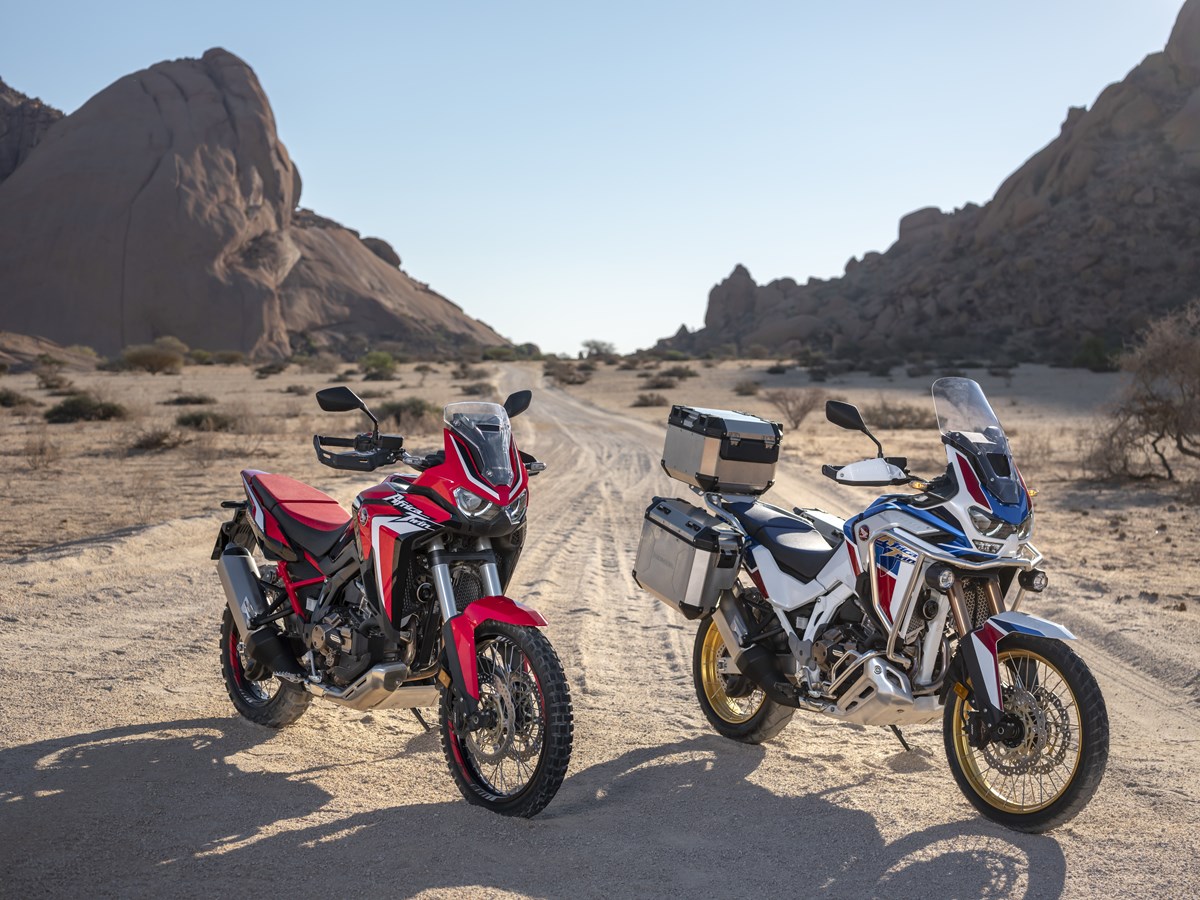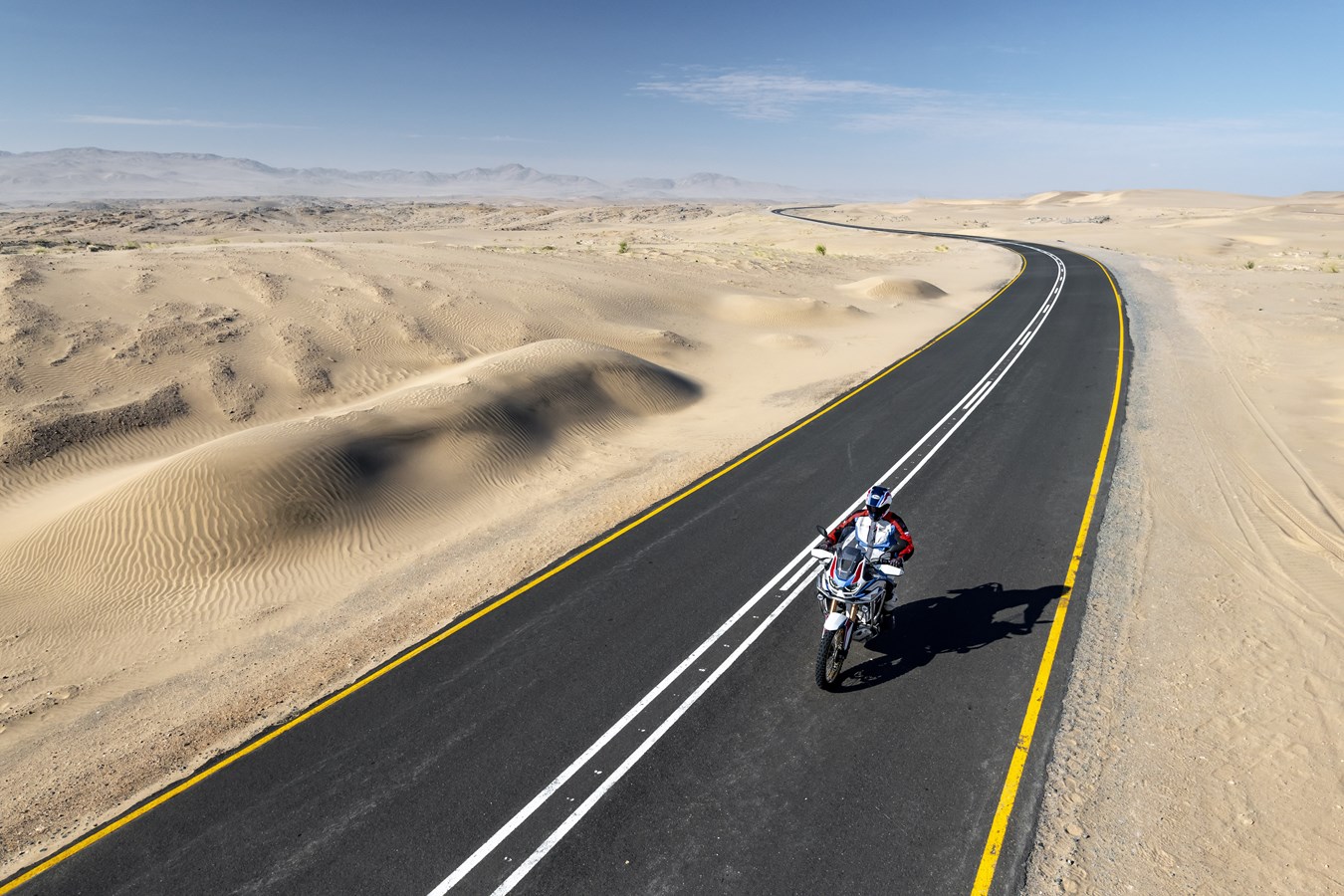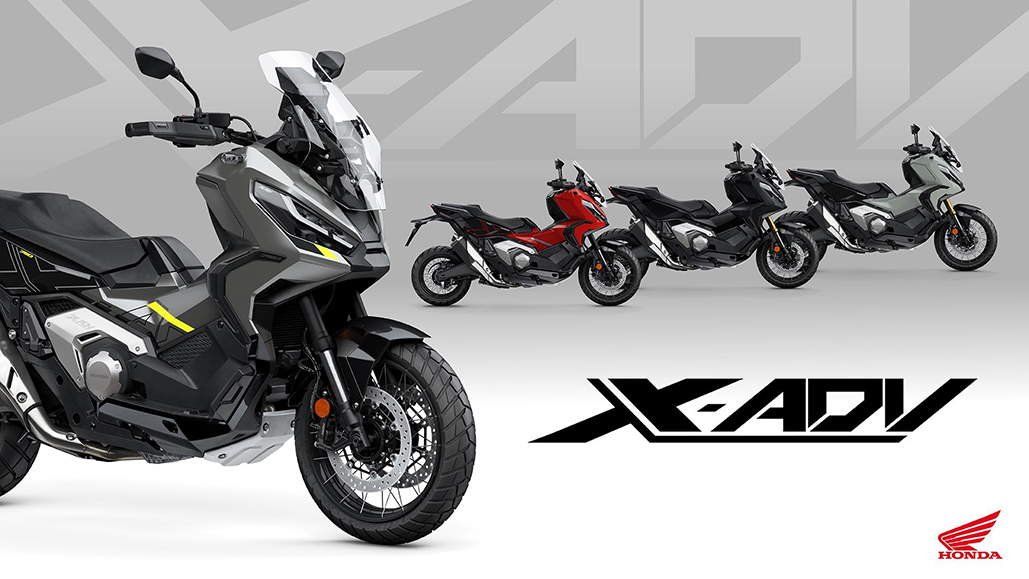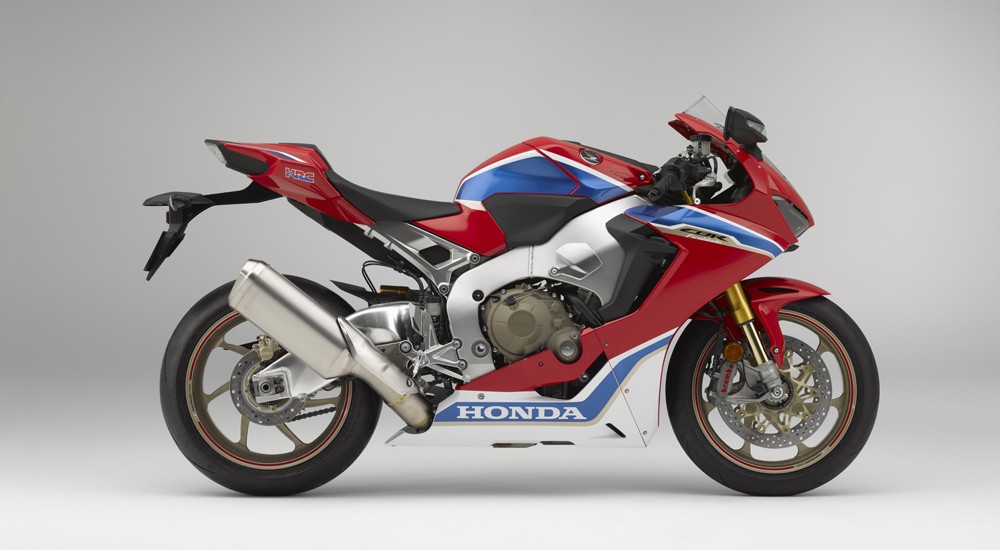2020 HONDA AFRICA TWIN

A major evolution for Honda’s definitive full-size adventurer: harder-edged off-road performance comes via lighter chassis, slim rally-style bodywork and revised riding position; weight is reduced by 5kg, while engine capacity is increased, boosting power and torque. It’s also EURO5 compliant. A six-axis Inertial Measurement Unit now manages riding modes and HSTC as well as three additional systems – Cornering ABS, Wheelie Control, Rear Lift Control, plus new cornering detection functionality on the DCT version. A full colour 6.5-inch TFT touchscreen incorporates Apple CarPlay® and Bluetooth connectivity. Dual LED headlights feature Daytime Running Lights (DRL) and cruise control is fitted as standard.
1. Introduction
It’s been over three decades since the Honda XRV650 Africa Twin first rolled into Europe and while the motorcycle that now bears its name – launched in 2016 as the CRF1000L Africa Twin – was a brand-new machine from the wheels up, it fully inherited the essence and spirit of what made the original so popular.
It was the balance between power and weight that was at the heart of the original bike’s appeal, just as it was for the new model. With its unique, athletic appearance, an enjoyable, usable engine and capable, comfortable chassis, the CRF1000L Africa Twin proved itself a true modern-day all-rounder and has been hugely popular with round-the-world adventurers, around-town commuters and weekend tourers alike.
2018 saw the Africa Twin, in both manual transmission and Dual Clutch Transmission (DCT) form, receive Throttle By Wire (TBW) control plus 3 riding modes, expanded Honda Selectable Torque Control (HSTC) options, as well as intake and exhaust development for improved engine response and sound. The platform also expanded: the Africa Twin Adventure Sports – with the same updates but featuring improved wind protection, greater tank range and longer-travel suspension – extended the machine even further into long-range off-road territory.
Building on strong European (and global) demand for both models, with over 87,000 sold worldwide since its 2016 relaunch, 2020 is set to be a landmark year for the Africa Twin.
The touring comfort, technology and ability of the new CRF1100L Africa Twin Adventure Sports* are further enhanced – and it adds the option of Showa Electronically Equipped Ride Adjustment (SHOWA EERA™). Meanwhile, the CRF1100L Africa Twin itself is comprehensively redrawn with an aggressive, compact rally style and even sharper off-road focus. It also packs more power and torque and is significantly lighter – in keeping with the first principles set out all those years ago.
*See separate CRF1100L Africa Twin Adventure Sports Press Kit.
2. Model Overview
The 2020 CRF1100L Africa Twin has a sharply-renewed focus on off-road core ability, that brings with it the look – and feel – of a true rally machine. Smaller, slimmer and 5kg lighter, it offers even more athletic performance, thanks also to changes to the engine, which now produces 7% more peak power, 6% more peak torque and is much stronger everywhere in the rev-range. It’s also EURO5 compliant.
The frame has been completely revised and now features a bolt-on aluminium subframe. The swingarm, too, is aluminium and based on that of the CRF450R moto-crosser. And at the centre of the Africa Twin, the addition of a six-axis Inertial Measurement Unit (IMU) controls not only the 7-level HSTC but also (new for 2020) 3-level Wheelie Control, Cornering ABS (with off-road setting), Rear Lift Control and DCT cornering detection. An OFF-ROAD setting also joins the URBAN, TOUR and GRAVEL default riding modes.
Tailored for complete control, the riding position features a slimmer-section seat and higher-set handlebars. A full colour Multi Information Display (MID) 6.5-inch TFT touch screen offers immersive engagement with the machine’s systems, plus Apple CarPlay® and Bluetooth connectivity. Dual LED Daytime Running Lights (DRL) are highly visible, improving safety, and cruise control is standard-fit.
3. Key Features
3.1 Styling & Equipment
- Compact body style designed for off-road, with slim seat and high handlebars
- Multi Information Display (MID) 6.5-inch TFT touch screen
- Apple CarPlay® allows use of Apple iPhone® through the MID
- Bluetooth connectivity, Daytime Running Lights (DRL) and cruise control
Aggressive and compact. Two words that sum up the Africa Twin’s taut new rally-style bodywork. And it’s for a reason – to work better off-road. The fixed screen is much shorter than before, to allow for easy scanning of the trail ahead and, while seat height remains 850-870mm, the handlebars now mount 22.5mm higher, giving a more upright riding position and comfortable control, whether standing or seated.
The tail section is slimmer and the seat itself is 40mm narrower, for easier ground reach; its shape has also been carefully contoured to allow easier back and forth movement. Low 825-845mm and high, 875-895mm seat options are also available as accessories.
New dual LED headlights are set higher, deliver a penetrating beam and also feature Daytime Running Lights (DRL) that automatically adjust to ambient light intensity, improving safety, no matter the conditions. Knuckle guards are standard.
The full colour Multi Information Display (MID) 6.5-inch TFT touch screen keeps the rider in control of all of the Africa Twin’s systems, with each of the riding modes selectable through the top left of the screen. The MID can also be customised to show various levels of information relative to the riding mode chosen and is easy to use even when wearing gloves.
It also incorporates Apple CarPlay®, allowing use of an Apple iPhone® through the touchscreen. Navigation apps can also be accessed and displayed and via a Bluetooth helmet headset calls can be made or received. The iPhone® itself plugs into a USB charging port on the right of the MID. Hands-free wireless Bluetooth connectivity is also an option for an iPhone® or Android device and all control inputs are made from the left-hand switchgear.
The front and rear indicators have an Emergency Stop Signal function. When braking suddenly over 50kph the hazard lights flash to warn other road users a hard stop is in process. They also auto-cancel; rather than using a simple timer, the system compares front and rear wheel speed difference and calculates when to cancel the indication relative to the situation.
For 2020 cruise control is now fitted as standard, to ease long-distance highway travel.
3.2 Engine
- Capacity rises to 1,084cc giving 75kW peak power and 105Nm peak torque
- Achieved through a new cylinder head, valve timing and lift, throttle body and exhaust
- Manual transmission ratios and gear material optimised, saving weight
- The muffler now features a variable Exhaust Control Valve (ECV) for improved low-rpm sound and high-rpm performance
The SOHC 8-valve parallel-twin engine’s essential architecture remains unchanged for 2020 but has a larger displacement of 1,084cc, up from 998cc. And as a result peak power goes from 70kW to 75kW @ 7,500rpm with peak torque going from 99Nm to 105Nm @ 6,250rpm. Significantly, the obvious increase in both power and torque makes itself felt from 2,500rpm all the way through to the redline.
To create the larger capacity, bore remains 92mm but stroke is longer at 81.5mm (from 75.1mm) with compression ratio of 10.1:1. The cylinder sleeves are also now aluminium. Along with other detailed weight savings in the transmission and elsewhere, the manual transmission engine is now 2.5kg lighter (at 66.4kg) than the previous design, the DCT version 2.2kg lighter at 74.9kg.
As before, the 270° phased crankshaft and uneven firing interval create the engine’s distinctive throb and feel for rear wheel traction. The cylinder head however is completely revised, as is the larger diameter 46mm throttle body; the bore and cylinder pitches are also now aligned to create a smooth air intake profile. The ECU setting is new and the injector angle has been modified to deliver a more direct spray into re-shaped twin-spark combustion chambers.
Honda’s SOHC Unicam valve train is a feature of the MX competition-specification CRF450R and the low-set position of the cast camshaft contributes to the compact nature of the cylinder head. For 2020 the valve timing has been optimised and inlet and exhaust valve lift increased to 10.1mm inlet and 9.3mm exhaust (from 9.2/8.6mm).
To match and deal with the uprated intake efficiency and higher output (thus gas flow) the exhaust end-can now features a variable Exhaust Control Valve (ECV) very similar to the unit fitted to the CBR1000RR Fireblade. It enhances both engine performance and efficiency as it opens at higher rpm and gives a pleasing exhaust note ‘pulse’ at lower rpm.
The crankcases are split vertically; the water pump is housed efficiently within the clutch casing with a thermostat integrated into the cylinder head. Manual and DCT versions of the engine share common crankcases with only minor external differences; the water and oil pumps are both driven by the engine’s balancer shafts.
It’s a semi-dry sump design with in-tank lower crankcase oil storage. This allows a lower pan depth, keeping overall engine height low. As the pressure-fed pump is located within the tank where it delivers its oil from, there is no need for a pressure-feed passage. Secondary vibrations are neutralised by the mutually reciprocating motion of the pistons, while primary inertial and coupling vibrations are cancelled by the use of biaxial balance shafts.
For 2020 precision of the front and rear balance gears has been improved, allowing removal of their scissor gears; the addition of a crank pulsar ring adds misfire detection, important for OBD2/EURO5 compliance. In addition for EURO5 the 02 lambda exhaust sensors have been replaced with Linear Air Fuel (LAF) sensors in the downpipes to allow for much more accurate measurement of the air/fuel mixture ratio.
The aluminium clutch centre and pressure plate use ‘assist’ cams to ease upshifts and ‘slipper’ cams for deceleration and downshifting; the clutch diameter is now smaller and features reduced spring tension for lighter lever feel. The gears are also re-shaped and constructed from stronger material. A quickshifter remains available as an optional extra.
3.3 Engine & Chassis Management Electronics
- IMU-managed HSTC intervention levels optimised for off-road use
- Wheelie Control features 3 levels and IMU management
- OFF-ROAD joins the default riding modes TOUR, URBAN and GRAVEL
- Two USER modes allow for complete riding modes customisation
The Africa Twin’s engine received the benefits of Throttle By Wire (TBW) control in 2018, allowing much finer management of engine output and character as well as expanded Honda Selectable Torque Control (HSTC) for rear tyre grip; for 2020 the system has smartly evolved and now works in conjunction with a six-axis IMU*.
The system offers 4 levels of power and 3 levels of engine braking. There are still seven levels of HSTC but each level’s amount of intervention has been optimised to work with real-time input (yaw/roll angle and rate) from the IMU. The spacing of the levels has been optimised to allow the rider a finer choice of the amount of rear tyre slide for off-road riding. HSTC can also be turned off completely.
Wheelie Control is another new feature. Again, with the IMU measuring pitch angle and rate, and controlling engine torque via TBW, the rider can choose between 3 levels of input. Level 1 allows for intended wheel lift but suppresses any sudden movement. Level 3 stops any front wheel elevation and level 2 is mid-way between the two. Wheelie Control can also be turned off completely.
There are four default riding mode settings: TOUR, URBAN, GRAVEL and OFF-ROAD to cover most riding conditions and situations plus two customisable USER settings. Even within the default riding modes, it’s possible to change some parameters – HSTC between levels 1-7 (plus off), Wheelie Control between levels 1-3 (plus off) and DCT S mode shift pattern levels 1-3.
TOUR employs the highest level of Power (1), for touring loaded with pillion and luggage plus mid-range Engine Braking (2) with active on-road Cornering ABS.
URBAN suits wide-ranging riding requirements and uses mid-level Power (2) and Engine Braking (2) with active on-road Cornering ABS.
GRAVEL delivers the lowest level of Power (4) and Engine Braking (3). Cornering ABS is active with an off-road setting; in this setting, the rear brake ABS cannot be switched off.
OFF-ROAD uses lower-mid level Power (3) and the lowest amount of Engine Braking (3). Cornering ABS is active with an off-road setting; the rear brake ABS can be switched off.
USER 1 & 2 modes offer the rider a choice of two distinct personalized setups – choosing between Power levels 1-4 and Engine Braking 1-3, and ABS on-road/off-road parameters.
*See the Chassis section 3.5 of this press kit.
3.4 Dual Clutch Transmission
- Super-fast gear changes in either Manual Transmission (MT) or Automatic D and S modes
- S mode (with 3 levels) revs higher and downshifts sooner than D, for more aggressive riding
- G switch improves rear wheel traction when off-road
- Incline detection adapts shift pattern depending on gradient
- IMU allows corning detection function for improved shift timings
Honda has sold over 100,000 DCT-equipped motorcycles across Europe since the system first appeared as an option on the VFR1200F a decade ago in 2009. Testament to its acceptance in the marketplace, during the last financial year, DCT accounted for 48% of European sales on models where DCT was an option.
The unique DCT system delivers consistent, super-fast seamless gear changes, and very quickly becomes second nature in use. It uses two clutches: one for start-up and 1st, 3rd and 5th gears: the other for 2nd, 4th and 6th, with the mainshaft for each clutch located inside the other for compact packaging.
Each clutch is independently controlled by its own electro-hydraulic circuit. When a gear change occurs, the system pre-selects the target gear using the clutch not currently in use. The first clutch is then electronically disengaged as, simultaneously, the second clutch engages.
The result is a consistent, fast and seamless gear change. Furthermore, as the twin clutches transfer drive from one gear to the next with minimal interruption of the drive to the rear wheel, any gear change shock and pitching of the machine is minimised, making the change feel direct as well as smooth.
The extra benefits of durability (as the gears cannot be damaged by missing a gear) impossibility of stalling, low stress urban riding and reduced rider fatigue add to DCT’s appeal
Three modes of operation are available. MT mode gives full manual control, allowing the rider to shift with the handlebar trigger control buttons. Automatic D mode is ideal for city and highway riding, and achieves optimum fuel efficiency. Automatic S mode offers three levels of sportier riding, as the ECU lets the engine rev a little higher before shifting up, and shifts down sooner when decelerating for extra engine braking.
In either D or S mode, DCT offers immediate manual intervention if required – the rider simply selects the required gear using the up and down shift triggers on the left handlebar. At an appropriate time, DCT seamlessly reverts back to automatic mode, depending on throttle angle, vehicle speed and gear position.
DCT for the Africa Twin is also fully equipped to operate in an adventure environment, with off-road functionality enhanced by the G switch accessed via the TFT touch screen display. Activating the G switch in any riding mode improves the feel for available traction and machine control by reducing the amount of clutch slip during gear changes.
Further functionality for the DCT system comes in the form of incline detection, by means of which the gear shift pattern is adapted depending on the grade of an incline to provide optimum control.
A new feature for the CRF1100L Africa Twin’s DCT system is cornering detection. When the IMU recognises the bike is cornering, the system subtly adjusts the shifting programme for the most natural gear changes.
3.5 Chassis
- A six-axis Inertial Measurement Unit is housed in the centre of the machine
- Revised, lighter frame, with bolt-on aluminium subframe and lighter, more rigid CRF450R-style swingarm for improved rear wheel traction and feel
- Cornering ABS provides sure-footed feel and features an off-road setting
- New damping and spring rates for the front and rear Showa suspension
At the very heart of the Africa Twin’s elevated on- and off-road performance is a Bosch MM7.10 six-axis Inertial Measurement Unit (IMU) tucked away at the centre of the machine, that measures – in real-time – roll angle/rate, pitch angle/rate and yaw angle/rate. It manages rear wheel traction via TBW and HSTC, front braking grip through Cornering ABS, front wheel lift through Wheelie Control and also adds Rear Lift Control.
In conjunction with the addition of IMU control for its 2020 evolution, the strength and rigidity balance of the steel semi-double cradle frame was completely re-examined by Honda’s development engineers to boost off-road ability – at the same time reinforcing its all-round on-road manners.
Rigidity around the steering head has been optimised to enhance feel for front end grip; the main spars are also slimmer and straighter and do away with the front cross pipe. Frame weight is 1.8kg lighter than before.
A bolt-on aluminium subframe (finished in red) replaces the integral steel structure of the previous design and is 40mm slimmer at a width of 195mm – crucial for easier ground reach. The aluminium swingarm is all-new, 500g lighter and based on the same design used by the CRF450R. Its improved rigidity improves rear wheel traction and rider feel.
Ground clearance remains 250mm, with wheelbase of 1575mm and rake and trail of 27° 30’/113mm. Wet weight is 5kg lighter, at 226kg.
With stroke length of 230mm the 45mm Showa cartridge-type inverted front fork offers long-travel bump absorption and features revised internal settings to improve both on- and off-road performance. Rebound and compression damping are fully adjustable. A cast aluminium top yoke and forged bottom yoke – joined by hollow aluminium stem shaft – clamp the fork legs with two bolts each top and bottom.
Similarly revised to match the front suspension the Showa rear shock delivers 220mm axle travel and features a 46mm cylinder and remote reservoir for stable damping control under extreme off-road riding conditions. Spring preload can be adjusted via a dial on the shock body; rebound and compression damping are also fully adjustable.
The swingarm pivot points’ inner plates now use 600MPa high-strength steel and the upper cross tube that connects them acts as the rear shock upper mount (through a pillow-ball joint) improving feel for rear wheel traction.
The IMU takes in lean angle, deceleration (from front/rear wheel speed sensors) and incorporates the slip rate of the front and rear wheels to manage braking pressure through the ABS; likewise if it detects sudden rear wheel lift, it finely controls brake force to maintain stability. When stationary the rear ABS can be cancelled for off-road riding.
As beFore, compact two-piece radial-mount four-piston calipers work dual 310mm ‘wave’ floating discs through sintered pads. The rear 256mm ‘wave’ disc features hole punching and shaping. 21/18-inch front rear (stainless steel) spoked wheels wear 90/90-21 and 150/70-18 tyres. Block pattern tyres (Continental 90/90-21M/C 54S and 150/70B 18M/C 70Q, rated at 180km/h and 160km/h respectively) are approved for fitment.
4 Accessories
The range of Honda Genuine Accessories for the Africa Twin has been expanded with luggage options that includes premium (42L) aluminium top box and panniers plus large (58L) plastic top box and panniers, two seat heights (a lower 825-845mm and taller 870-895mm option), touring screen, radiator guards, engine guards and side pipes, knuckle guard extensions, heated grips and an ACC charging socket.
5 Technical Specifications
| ENGINE | |
| Type | SOHC liquid-cooled 4-stroke 8-valve parallel twin with 270° crank and Uni-cam |
| Displacement | 1084cc |
| Bore & Stroke | 92mm x 81.5mm |
| Compression Ratio | 10.1:1 |
| Max. Power Output | 75kW at 7,500rpm |
| Max. Torque | 105Nm at 6,250rpm |
| Noise Level | 73dB |
| Oil Capacity | 4.8/4.3 (5.2/4.7 DCT) |
| FUEL SYSTEM | |
| Carburation | PGM-FI |
| Fuel Tank Capacity | 18.8L |
| CO2 Emissions | 112g/km MT
110g/km DCT |
| Fuel Consumption | 4.9L/100km (20.4km/L) MT
4.8L/100km (20.8km/L) DCT |
| ELECTRICAL SYSTEM | |
| Starter | Electric |
| Battery Capacity | 12V-6Ah Li-ion battery (20hr) |
| ACG Output | 0.49 kW/5,000rpm |
| DRIVETRAIN | |
| Clutch Type | Wet, multiplate with coil springs, aluminium cam assist and slipper clutch
DCT – 2 wet multiplate clutches with coil springs |
| Transmission Type | 6 speed manual (6 speed DCT) |
| FRAME | |
| Type | Semi double cradle |
| CHASSIS | |
| Dimensions (L´W´H) | 2330mm x 960mm x 1395mm |
| Wheelbase | 1575mm |
| Caster Angle | 27.5° |
| Trail | 113mm |
| Seat Height | 850/870mm (low seat option 825mm, high seat option 895mm) |
| Ground Clearance | 250mm |
| Kerb Weight | 226kg (DCT 236kg) |
| SUSPENSION | |
| Type Front | Showa 45mm cartridge-type inverted telescopic fork with dial-style preload adjuster and DF adjustments, 230mm stroke |
| Type Rear | Monoblock aluminium swing arm with Pro-Link with Showa gas-charged damper, hydraulic dial-style preload adjuster and rebound damping adjustments, 220 mm rear wheel travel |
| WHEELS | |
| Type Front | 21M/C x 2.15 wire spoke with aluminium rim |
| Type Rear | 18M/C x MT4.00 wire spoke with aluminium rim |
| Rim Size Front | 21″ |
| Rim Size Rear | 18″ |
| Tyres Front | 90/90-21M/C 54H (tube type)
(Bridgestone Battlax Adventurecross Tourer AX41T / Metzler Karoo Street) |
| Tyres Rear | 150/70R18M/C 70H (tube type)
(Bridgestone Battlax Adventurecross Tourer AX41T / AX41T Metzler Karoo Street) |
| BRAKES | |
| ABS System Type | 2 channel with IMU Selectable ABS MODE with on-road and off-road setting |
| Type Front | 310mm dual wave floating hydraulic disc with aluminium hub and radial fit 4-piston calipers and sintered metal pads |
| Type Rear | 256mm wave hydraulic disc with single piston caliper and sintered metal pads. 2-channel with rear ABS OFF mode. |
| INSTRUMENTS & ELECTRICS | |
| Instruments | LCD Meter, TFT 6.5inch touch panel multi information display |
| Security System | Immobiliser, security alarm (optional) |
| Headlight | LED |
| Taillight | LED |
| Electrics | Daytime running lights, Bluetooth audio and Apple Carplay, USB socket, auto turn signal cancel, cruise control, emergency stop signal, IMU, HSTC and wheelie control) |
** Please note that the figures provided are results obtained by Honda under standardised testing conditions prescribed by WMTC. Tests are conducted on a rolling road using a standard version of the vehicle with only one rider and no additional optional equipment. Actual fuel consumption may vary depending on how you ride, how you maintain your vehicle, weather, road conditions, tire pressure, installation of accessories, cargo, rider and passenger weight, and other factors.














